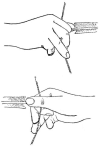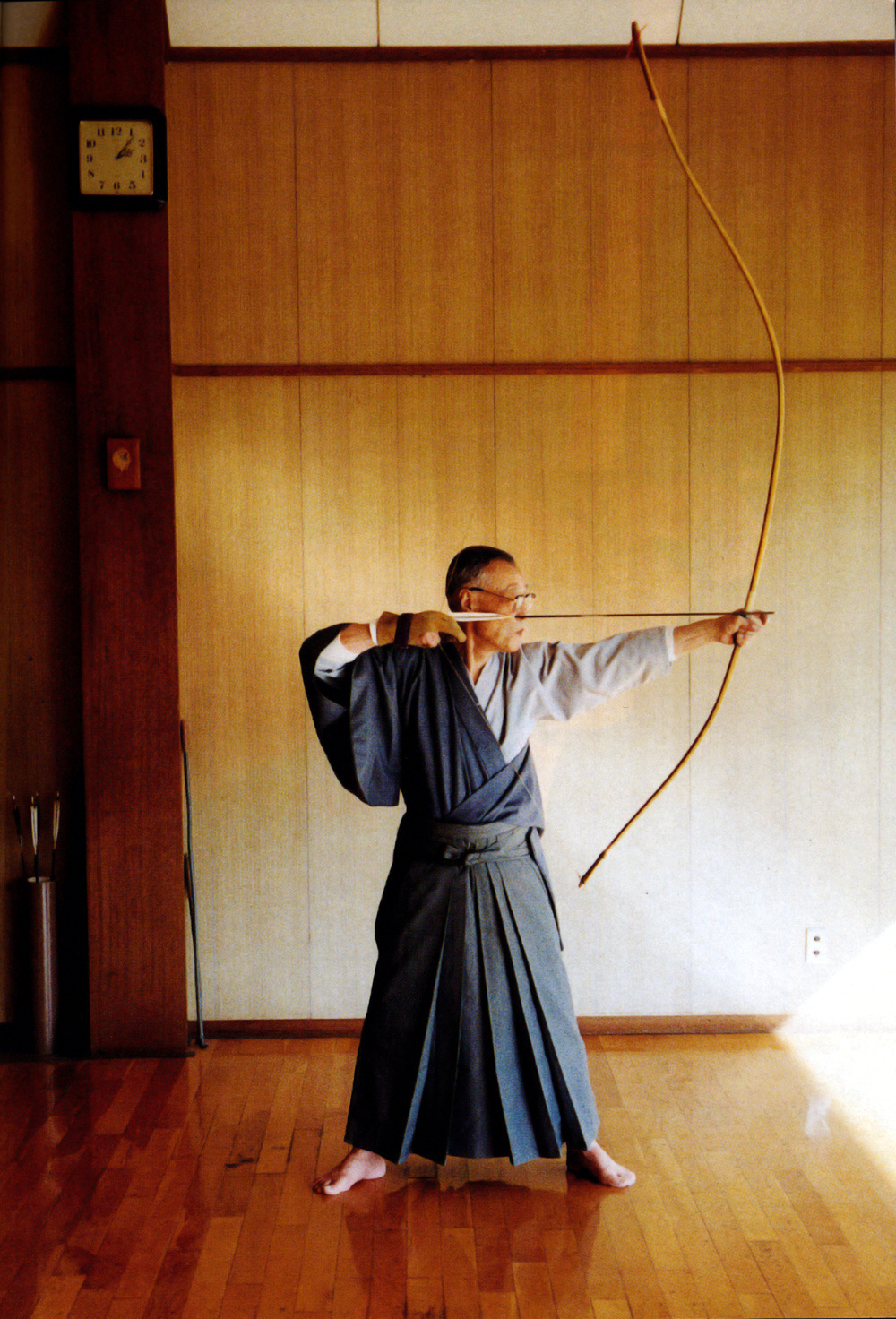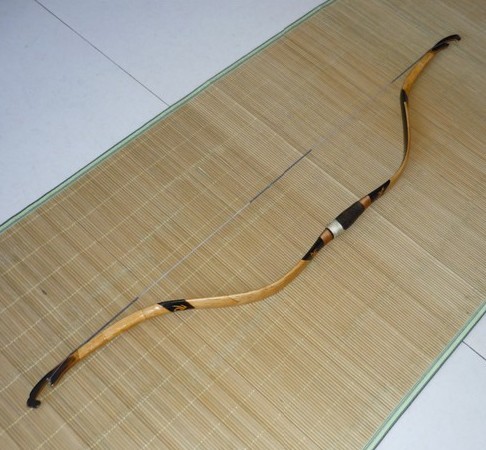|
Bow Draw
A bow draw in archery is the method or technique of pulling back the bowstring to store energy for the bow (weapon), bow to shoot an arrow. The most common method in modern target archery is the Mediterranean draw, which has long been the usual method in European archery. Other methods include the pinch draw and the Mongolian or "thumb" draw. In traditional archery practice outside Western Europe the variations of the thumb draw are by far the most dominant draw types, with the Mediterranean draw restricted to the Archery at the Summer Olympics, Olympic style of target archery. Pinch draw and release The pinch draw squeezes the end of the arrow between the thumb and index finger. Most people use this draw naturally when they first start shooting. This is often called the "primary draw/release"; the advantage of this draw is that the release is very clean; when the pull reaches a certain point, friction can no longer hold the arrow and it flies free. However, this release prevents ... [...More Info...] [...Related Items...] OR: [Wikipedia] [Google] [Baidu] |
Archery
Archery is the sport, practice, or skill of using a Bow and arrow, bow to shooting, shoot arrows.Paterson ''Encyclopaedia of Archery'' p. 17 The word comes from the Latin ''arcus'', meaning bow. Historically, archery has been used for hunting and combat. In modern times, it is mainly a competitive sport and recreational activity. A person who practices archery is typically called an archer, bowman, or toxophilite. History Origins and ancient archery The oldest known evidence of arrows (not found with surviving bows) comes from South Africa, South African sites such as Sibudu Cave, where the remains of bone and stone arrowheads have been found dating approximately 72,000 to 60,000 years ago.Backwell L, d'Errico F, Wadley L.(2008). Middle Stone Age bone tools from the Howiesons Poort layers, Sibudu Cave, South Africa. Journal of Archaeological Science, 35:1566–1580. Backwell L, Bradfield J, Carlson KJ, Jashashvili T, Wadley L, d'Errico F.(2018). The antiquity of bow-and-arro ... [...More Info...] [...Related Items...] OR: [Wikipedia] [Google] [Baidu] |
Thumb Ring
A thumb ring is a ring meant to be worn on one's thumb. Most commonly, thumb rings are used as an archery equipment designed to protect the thumb pulp from the bowstring during a thumb draw, and are made of leather, stone, horn, wood, bone, antler, ivory, metal, ceramics, plastic or glass. It usually fits over the distal phalanx of the thumb, coming to rest at the distal edge of the interphalangeal joint. Typically a flange extends from the ring to cover the thumb pulp, and may be supplemented by a leather extension. In some cultures, thumb rings also serve a decorative function like other types of rings, and are used to signal social status or ranks. In East Asia, such thumb rings are usually made of jade. Uses Archery The most common use of a thumb ring throughout history has been its role in archery. When drawing a bow using a thumb draw, the thumb is hooked around the bowstring just beneath the arrow and its grip reinforced with the first (sometimes second) finger ... [...More Info...] [...Related Items...] OR: [Wikipedia] [Google] [Baidu] |
Release Aid
In archery, a release aid, mechanical release, or release is a device that helps to fire arrows more precisely, by using a trigger to release the bowstring, rather than the archer's fingers. It is used to make the release of the bowstring quicker and reducing the amount of torque put onto the bowstring from the archer's fingers. Use Archers using compound bows most commonly use a release aid to hold the string and release it precisely, although finger tabs are also popular with compound bows, especially among older archers who have used finger tabs when shooting recurve bows. The release aid attaches to the bowstring just below the nocking point or at the D loop and permits the archer to release the string by the use of some form of trigger. When such a device was first invented (patent filed in USA, 1879) it was known as a "clutch". The trigger may be an actual trigger lever which is depressed by a finger or thumb (positive), or held and then released (negative); there are nume ... [...More Info...] [...Related Items...] OR: [Wikipedia] [Google] [Baidu] |
World Archery Federation
World Archery (WA, formerly ''Fédération Internationale de Tir à l'Arc'' (FITA)) is the governing body of the sport of archery. It is based in Lausanne, Switzerland. It is composed of 156 national federations and other archery associations, and is recognised by the International Olympic Committee. History FITA was founded on 4 September 1931 in Lwow, Poland (today Lviv, Ukraine). Its seven founding member states were France, Czechoslovakia, Sweden, Poland, the United States, Hungary, and Italy. The aim of the organization was to create regular archery championships, and to return archery to the Olympic Games (the sport had not been featured since 1920). FITA was finally successful in returning archery to the Olympic program in the 1972 Summer Olympics. To celebrate the organization's 80th anniversary in July 2011, a large majority of the FITA Congress voted to change the name from FITA to the World Archery or WA. In March 2022, in the wake of the 2022 Russian invasion of Ukr ... [...More Info...] [...Related Items...] OR: [Wikipedia] [Google] [Baidu] |
Compound Bow
In modern archery, a compound bow is a bow that uses a levering system, usually of cables and pulleys, to bend the limbs. The compound bow was first developed in 1966 by Holless Wilbur Allen in North Kansas City, Missouri, and a US patent was granted in 1969. Compound bows are widely used in target practice and hunting. Compound bows are typically constructed of man-made materials such as fiberglass and carbon fiber, while traditional bows and warbows usually are entirely or partially made of wood or bamboo. The pulley/cam system grants the user a mechanical advantage, and so the limbs of a compound bow are much stiffer than those of a recurve bow or longbow. This rigidity makes the compound bow more energy-efficient than traditional bows, as less energy is dissipated in limb movement. The higher-rigidity, more advanced construction also improves accuracy by reducing the bow's sensitivity to changes in temperature and humidity. In literature of the early 20th century, bef ... [...More Info...] [...Related Items...] OR: [Wikipedia] [Google] [Baidu] |
Thumb Ring
A thumb ring is a ring meant to be worn on one's thumb. Most commonly, thumb rings are used as an archery equipment designed to protect the thumb pulp from the bowstring during a thumb draw, and are made of leather, stone, horn, wood, bone, antler, ivory, metal, ceramics, plastic or glass. It usually fits over the distal phalanx of the thumb, coming to rest at the distal edge of the interphalangeal joint. Typically a flange extends from the ring to cover the thumb pulp, and may be supplemented by a leather extension. In some cultures, thumb rings also serve a decorative function like other types of rings, and are used to signal social status or ranks. In East Asia, such thumb rings are usually made of jade. Uses Archery The most common use of a thumb ring throughout history has been its role in archery. When drawing a bow using a thumb draw, the thumb is hooked around the bowstring just beneath the arrow and its grip reinforced with the first (sometimes second) finger ... [...More Info...] [...Related Items...] OR: [Wikipedia] [Google] [Baidu] |
Finger Tab
In archery, a finger tab or archer tab is a small leather or synthetic patch that protects an archer's fingers from the bowstring. It is strapped or otherwise attached to an archer's hand. In summertime, tabs are far more comfortable than gloves and can more conveniently use thicker material. They are also less expensive and easier to fit, and are the normal finger-protection used with recurve bows. The tab usually has a retaining loop on the back of the tab that fits over the middle finger, which is simply there to keep the tab on the fingers when the string is loosed. Tabs come in various forms. The simplest is made of a single patch that is placed below the nocking point between the fingers and the string. This style of shooting is called 'three finger under'. These are most often used in barebow styles of archery. More complex tabs have a split about one third down the leading edge so that the fingers can be placed with one finger above and two fingers below the nocking p ... [...More Info...] [...Related Items...] OR: [Wikipedia] [Google] [Baidu] |
Kyūdō
''Kyūdō'' () is the Japanese martial art of archery. Kyūdō is based on ''kyūjutsu'' ("art of archery"), which originated with the samurai class of feudal Japan. In 1919, the name of kyūjutsu was officially changed to kyūdō, and following the example of other martial arts that have been systematizing for educational purposes, kyūdō also reorganized and integrated various forms of shooting that had been used up until then. Many practitioners may refer to themselves as ''yumihiki'' (弓引き), or 'ones who draw the bow'. Kyūdō is practised by over a hundred thousand people worldwide. The bow they use is called a . It has an asymmetrical shape and length of more than , and its use is characterized by the archer gripping the lower third of the bow stave to shoot. History The beginning of archery in Japan is pre-historical. The first images picturing the distinct Japanese asymmetrical longbow are found on Dōtaku from the Yayoi period (c. 500 BC – 300 AD). Emerge ... [...More Info...] [...Related Items...] OR: [Wikipedia] [Google] [Baidu] |
Composite Bow
A composite bow is a traditional bow made from horn, wood, and sinew laminated together, a form of laminated bow. The horn is on the belly, facing the archer, and sinew on the outer side of a wooden core. When the bow is drawn, the sinew (stretched on the outside) and horn (compressed on the inside) store more energy than wood for the same length of bow. The strength can be made similar to that of all-wood "self" bows, with similar draw-length and therefore a similar amount of energy delivered to the arrow from a much shorter bow. However, making a composite bow requires more varieties of material than a self bow, its construction takes much more time, and the finished bow is more sensitive to moisture. Archaeological finds and art indicate composite bows have existed since the second millennium BCE, but their history is not well recorded, being developed by cultures without a written tradition. They originated among Asiatic pastoralists who used them as daily necessities, ... [...More Info...] [...Related Items...] OR: [Wikipedia] [Google] [Baidu] |
Gutenberg
Johannes Gensfleisch zur Laden zum Gutenberg ( – 3 February 1468) was a German inventor and craftsman who invented the movable-type printing press. Though movable type was already in use in East Asia, Gutenberg's invention of the printing press enabled a much faster rate of printing. The printing press later spread across the world, and led to an information revolution and the unprecedented mass-spread of literature throughout Europe. It had a profound impact on the development of the Renaissance, Reformation, and humanist movements. His many contributions to printing include the invention of a process for mass-producing movable type; the use of oil-based ink for printing books; adjustable molds; mechanical movable type; and the invention of a wooden printing press similar to the agricultural screw presses of the period. Gutenberg's method for making type is traditionally considered to have included a type metal alloy and a hand mould for casting type. The alloy was a m ... [...More Info...] [...Related Items...] OR: [Wikipedia] [Google] [Baidu] |







